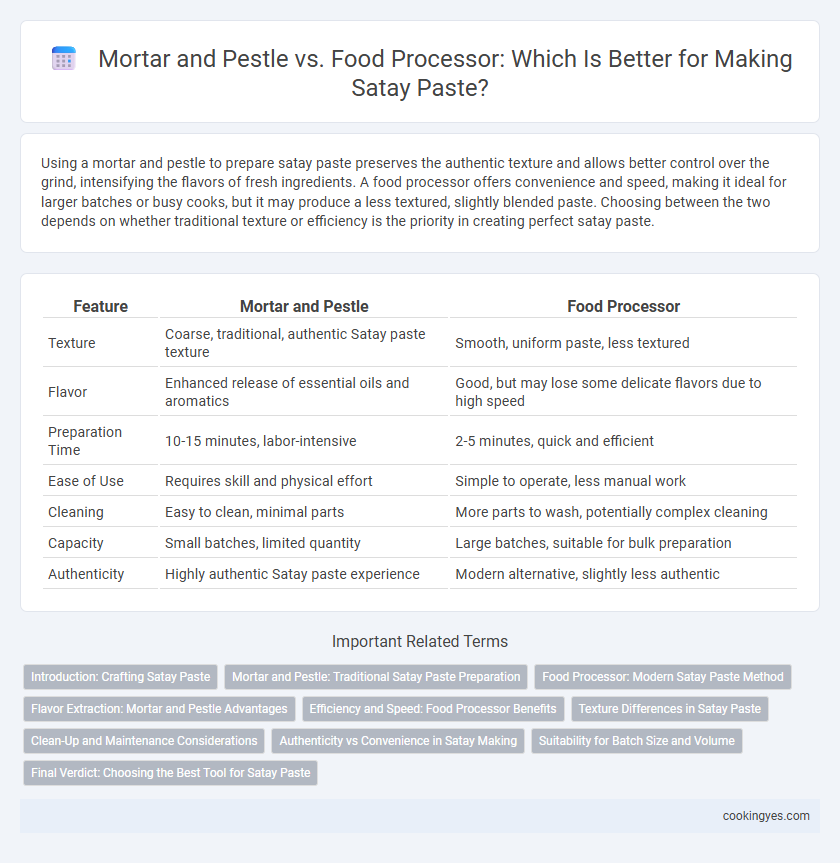Using a mortar and pestle to prepare satay paste preserves the authentic texture and allows better control over the grind, intensifying the flavors of fresh ingredients. A food processor offers convenience and speed, making it ideal for larger batches or busy cooks, but it may produce a less textured, slightly blended paste. Choosing between the two depends on whether traditional texture or efficiency is the priority in creating perfect satay paste.
Table of Comparison
| Feature | Mortar and Pestle | Food Processor |
|---|---|---|
| Texture | Coarse, traditional, authentic Satay paste texture | Smooth, uniform paste, less textured |
| Flavor | Enhanced release of essential oils and aromatics | Good, but may lose some delicate flavors due to high speed |
| Preparation Time | 10-15 minutes, labor-intensive | 2-5 minutes, quick and efficient |
| Ease of Use | Requires skill and physical effort | Simple to operate, less manual work |
| Cleaning | Easy to clean, minimal parts | More parts to wash, potentially complex cleaning |
| Capacity | Small batches, limited quantity | Large batches, suitable for bulk preparation |
| Authenticity | Highly authentic Satay paste experience | Modern alternative, slightly less authentic |
Introduction: Crafting Satay Paste
Crafting authentic satay paste relies heavily on the right method to blend spices and ingredients. Using a mortar and pestle allows for precise control over texture and releases essential oils, enhancing the flavor complexity of traditional satay. In contrast, a food processor offers speed and convenience but may sacrifice the nuanced taste developed by the slow grinding process essential for rich, aromatic satay paste.
Mortar and Pestle: Traditional Satay Paste Preparation
Mortar and pestle enable authentic satay paste preparation by manually grinding spices and herbs, preserving the essential oils and flavor complexity that define traditional Indonesian satay. This method ensures a coarse, textured paste with enhanced aroma, often lost in the fast processing of food processors. Using a mortar and pestle aligns with cultural authenticity, delivering a richer and more genuine taste experience in satay dishes.
Food Processor: Modern Satay Paste Method
Using a food processor for satay paste preparation offers a modern, time-saving alternative to the traditional mortar and pestle method, efficiently blending ingredients into a smooth, consistent paste. Its high-speed blades effectively break down tough spices and nuts, ensuring even texture and enhanced flavor release crucial for authentic satay taste. The food processor also allows precise control over paste thickness, accommodating variations in satay recipes and catering to contemporary kitchen convenience.
Flavor Extraction: Mortar and Pestle Advantages
Using a mortar and pestle for satay paste significantly enhances flavor extraction by crushing ingredients slowly and gently, releasing essential oils and aromas more effectively than a food processor. The manual grinding action preserves the texture and allows better control over the paste consistency, resulting in a richer, more authentic taste. Traditional chefs prefer this method for its ability to meld spices and herbs into a harmonious blend that elevates the satay's overall flavor profile.
Efficiency and Speed: Food Processor Benefits
Using a food processor for satay paste significantly enhances efficiency and speed by quickly blending ingredients into a smooth, consistent texture. Unlike the traditional mortar and pestle, which requires manual effort and time-consuming grinding, a food processor can handle large quantities rapidly, reducing preparation time. This makes food processors ideal for busy kitchens aiming to maintain authentic flavors without compromising on productivity.
Texture Differences in Satay Paste
Mortar and pestle create a coarser, more textured satay paste by crushing ingredients manually, which releases essential oils and preserves subtle flavors. Food processors produce a smoother, more uniform paste but can slightly alter the natural aroma and texture due to high-speed blending. Traditional satay paste benefits from the rustic, chunky consistency of mortar and pestle, enhancing the overall mouthfeel and authentic experience.
Clean-Up and Maintenance Considerations
Cleaning a mortar and pestle after making satay paste requires thorough handwashing to remove sticky residues and can be time-consuming due to its textured surface. A food processor offers quicker clean-up with detachable, dishwasher-safe parts, simplifying maintenance and saving time. However, mortar and pestle maintain traditional authenticity without complicated mechanical parts, making it more durable and easier to keep in good condition long-term.
Authenticity vs Convenience in Satay Making
Using a mortar and pestle for satay paste preserves the authentic texture and releases essential oils from fresh ingredients, enhancing traditional flavor profiles crucial to true satay. In contrast, a food processor offers convenience and speed, efficiently blending spices but sometimes compromising the depth and subtlety of the paste. Choosing between these tools depends on prioritizing authentic taste achieved through manual grinding or the practical benefit of rapid preparation in busy kitchens.
Suitability for Batch Size and Volume
Mortar and pestle excel in small-batch satay paste preparation, offering precise control over texture and flavor extraction ideal for traditional recipes. Food processors handle larger volumes efficiently, enabling quick and consistent blending for commercial or high-demand settings without compromising the complexity of ingredients. Choosing between these tools depends on the desired batch size, with mortar and pestle preferred for artisanal quality and food processors favored for scalability and time-saving in mass production.
Final Verdict: Choosing the Best Tool for Satay Paste
Mortar and pestle preserve the authentic texture and aroma of satay paste by allowing gradual blending of spices, enhancing traditional flavors. Food processors offer speed and convenience, efficiently grinding ingredients into a smooth, consistent paste ideal for larger batches. Choosing between the two depends on balancing authenticity versus efficiency, with mortar and pestle preferred for richness in taste and food processors favored for time-saving and uniformity.
Mortar and Pestle vs Food Processor for Satay Paste Infographic

 cookingyes.com
cookingyes.com